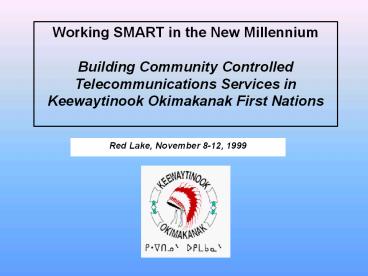Working SMART in the New Millennium - PowerPoint PPT Presentation
Title:
Working SMART in the New Millennium
Description:
K-Net staff and consultants (John Rowlandson and Florence Woolner) ... One expectation per card. This is what it looked like when we did it in Guelph, 28 Oct. ... – PowerPoint PPT presentation
Number of Views:21
Avg rating:3.0/5.0
Title: Working SMART in the New Millennium
1
Working SMART in the New Millennium Building
Community Controlled Telecommunications Services
in Keewaytinook Okimakanak First Nations
Red Lake, November 8-12, 1999
2
Step 1
A planning conference to explore Keewaytinook
Okimakanak First Nations telecommunication
strategy and future directions.
3
Who are we all?
What are our expectations?
first morning
Whats in it for me? How can I shape this?
Why are we here?
4
- Who are we?
- Keewaytinook Okimakanak First Nation leaders and
staff in education, health, management,
government, and program support. - K-Net staff and consultants (John Rowlandson and
Florence Woolner) - TeleCommons Development Group (TDG) consultants
(Don Richardson and Ricardo Ramirez) - Guest Presentations via videoconference
5
Why are we here?
These guys are crazy...
you invited him
...Brian looks like he wants action, not just
talk now what?
Oct. 28, 1998
6
Assumptions... Keewaytinook Okimakanak leaders
and K-Net services staff are interested in
harnessing information communication technologies
(ICTs) and making them work towards First
Nations' goals. Don Ricardo are interested to
learn how Keewaytinook Okimakanak leaders and
K-Net services have brought ICTs into the
communities. (PACTS and beyond.) Don Ricardo
wish to share tools for visualizing information
to help different stakeholder agree on what is
important and what needs to be tracked.
7
What are our expectations?
- Draw or write
- One expectation per card
- This is what it looked like when we did it in
Guelph, 28 Oct., 1998
8
Whats in it for me?
- There is something in it for you if...
- you use ICTs, or want to try them
- you want to control ICTs
- you want to make ICTs work for your goals
- you want to learn how to track impact
9
How can I shape this conference?
Tell us how you would like to change this first
agenda...
10
Conference Activities
- Review ICT strategy for Keewaytinook Okimakanak.
- Demonstration of the various communication
technologies and applications in First Nations - Identification of major challenges.
- Development of learning points
- Identification of progress indicators
- Meetings with other groups, organizations and
government officials to learn about their
services and projects.
11
Why do we visualize information?
- To capture different peoples ways of seeing
things - To see the many dimensions and issues that matter
- To have a tool that helps people plan in groups

